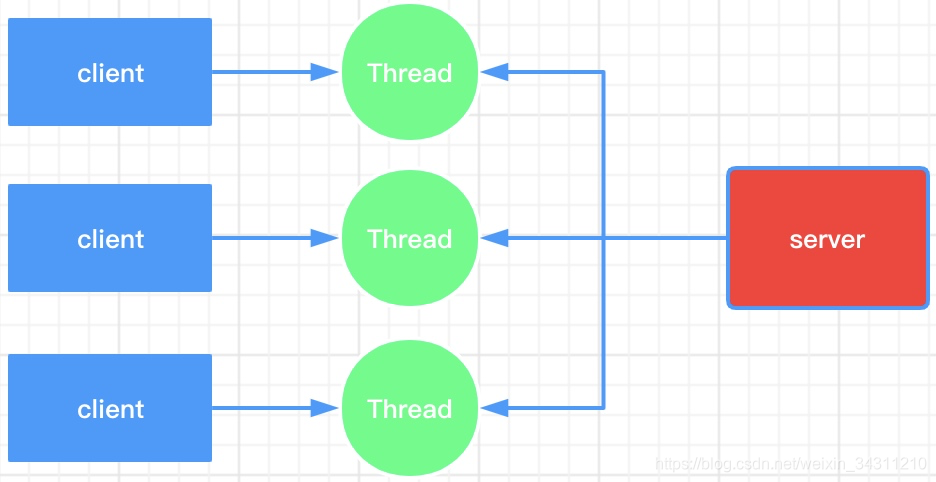IO模型指的是在网络数据传输过程中,使用什么通道去发送和接收数据,我们常见的有BIO、NIO、AIO(NIO2.0),我接下来会对这些进行详细的介绍
同步/异步/阻塞/非阻塞 到底是什么意思?
-
同步/异步
指的是你去调用一个方法,如果这个方法是同步的,那么你就会等待这个方法执行结束后才能执行后续操作;
如果是异步的话,他会立即给你返回,但是这个不是真实的结果,真实的结果它是通过消息机制通知你或者回调机制通知你的。 -
阻塞/非阻塞
阻塞指的是当你去调用一个获取洗衣机信息方法的时候,如果这个时候没有洗衣机,那么方法就会一直阻塞,直到能查询到洗衣机的信息才会返回结果;
非阻塞指的是当你调用一个获取洗衣机信息方法的时候,如果当时没有查到信息,你不会一直阻塞在那里,你这时可以去做别的事,但是你会时不时的去检查下是否有结果,然后再阻塞获取下,但是这不会影响你做其它事。
BIO(同步阻塞)
我们经常使用的就是BIO,在我们学习编程基础javaSE的时候,大家应该都会学过socket通信,这里面使用的就是同步阻塞。
我们先看下BIO的模型:

在BIO模型中,一个连接会对应一个处理线程,如果服务端使用单线程进行处理,后续连接将会一直阻塞;
- 缺点:
- 代码中的read操作是阻塞操作,如果连接之后,服务端一直不发送数据,将会一直阻塞当前线程,浪费资源。
- 如果连接数很多,意味着创建的线程数量就会越来越多,会造成服务器压力太大,后续优化成线程池处理方式,勉强解决了此问题。
- 应用场景
BIO适用于连接数较少且固定的架构,这种模式对服务器资源要求较高,但程序复杂度比较低;
代码示例
// 客户端
package com.example.netty.bio;
import java.io.IOException;
import java.net.Socket;
public class SocketClient {
public static void main(String[] args) throws IOException {
Socket socket = new Socket("127.0.0.1",9000);
socket.getOutputStream().write("我是客户端".getBytes());
socket.getOutputStream().flush();
System.out.println("向服务端发送数据结束");
byte[] bytes = new byte[1024];
try {
int read = socket.getInputStream().read(bytes);
System.out.println("服务端发送过来的数据为:"+new String(bytes,0,read));
} catch (IOException e) {
e.printStackTrace();
}finally {
}
}
}
//服务端
package com.example.netty.bio;
import java.io.IOException;
import java.net.ServerSocket;
import java.net.Socket;
public class SocketServer{
public static void main(String[] args) throws IOException {
ServerSocket serverSocket=new ServerSocket(9000);
while (true){
System.out.println("等待连接");
// 阻塞等待
Socket client = serverSocket.accept();
System.out.println("有客户端连接了");
handleRead(client);
}
}
/**
*
* @param client
*/
private static void handleRead(Socket client) {
new Thread(new Runnable() {
@Override
public void run() {
byte[] bytes = new byte[1024];
try {
int read = client.getInputStream().read(bytes);
System.out.println("客户端发送过来的数据为:"+new String(bytes,0,read));
// Thread.sleep(Integer.MAX_VALUE);
client.getOutputStream().write("你好,我收到你的数据了".getBytes());
client.getOutputStream().flush();
} catch (IOException e) {
e.printStackTrace();
} catch (InterruptedException e) {
e.printStackTrace();
} finally {
}
}
}).start();
}
}
NIO(同步非阻塞)
NIO在BIO的基础上进行了升级,将阻塞换成非阻塞,虽然只是模式变了下,但是代码复杂量却增加了不少。
在NIO模型中,服务端可以开启一个线程处理多个连接,它是非阻塞的,客户端发送的数据都会注册到多路复用器selector上面,当selector(selector的select方法是阻塞的)轮询到有读、写或者连接请求时,才会转发到后端程序进行处理,没有数据的时候,业务程序并不需要阻塞等待。
NIO有三大组件:Channel(通道)、Buffer(缓存区)、Selector(选择器)
- Channel
类似于流,但是它是一个双向的流,他是连接服务端和客户端的通道,不管是客户端还是服务端,都可以使用对通道进行读写数据。 - Buffer
它就是一个缓冲区,用来存放数据的载体,它借助通道,在客户端和服务端之间传递数据。 - Selector
它对应一个或多个线程,客户端的连接都会注册到selector上面,然后由selector去调用后端处理程序
NIO结构模型

NIO的非阻塞到底体现在哪里呢?
看模型图大家有可能都知道,客户端所有的连接通道都会注册到selector上面,select会通过轮询去获取这些通道的状态,这些状态有accpet(连接请求)、READ读请求。
如果在轮询过程中发现已经有一个连接请求状态的话,这说明已经有一个客户端想要和服务端进行连接,直接把这个通道传给后端程序去处理连接操作;如果是在BIO模型下的话,会一直阻塞在accept上,直到有连接请求才会释放,继续执行后续的代码。
如果在轮询过程中发现已经有一个读请求状态的话,这说明已经有一个客户端把数据发送给服务端了,服务端可以直接把通道交给后端程序进行读操作的处理;如果是在BIO模型下的话,会一直阻塞的read上,直到有连接请求才会释放,继续执行后续的代码。
以上可以总结为:在NIO模型中,如果服务端执行了read操作的话,就说明已经有可用的数据进行读取了,如果执行了accpet操作的话,就说明此时一定有客户端发起了与服务端的连接,能够保证这种操作的前提是selector轮询到了可读可连接的通道状态。
如果selector轮询后,得到了多个通道的read和accpet状态,NIO是如何处理的?
-
单线程
如果在单线程模式下,处理方式是按照轮询后得到的变化的通道的先后顺序进行处理的,没错,它是同步进行处理的,也就是它只能处理完这个通道的操作,才能继续处理下个通道的请求,在selector代码中,是通过遍历所有有变化的通道进行处理的,后面大家看代码就明白了,这种一个selector对应一个线程的模式其实就是redis的单线程IO模型。 -
多线程
如果是在多线程模式下,selector在遍历每一个通道的时候,都会把对通道的操作交给一个线程去处理,一般都会丢到线程中去处理,这个时候执行顺序就得看cpu的调度情况来决定了。
接下来我们结合代码来整体看下NIO的工作机制
代码示例
- 服务端代码
package com.example.netty.nio;
import java.io.IOException;
import java.net.InetSocketAddress;
import java.nio.ByteBuffer;
import java.nio.channels.SelectionKey;
import java.nio.channels.Selector;
import java.nio.channels.ServerSocketChannel;
import java.nio.channels.SocketChannel;
import java.util.Iterator;
public class NioServer {
public static void main(String[] args) throws IOException {
ServerSocketChannel serverSocketChannel = ServerSocketChannel.open();
serverSocketChannel.configureBlocking(false);
serverSocketChannel.socket().bind(new InetSocketAddress(9000));
Selector selector = Selector.open();
serverSocketChannel.register(selector, SelectionKey.OP_ACCEPT);
while (true) {
System.out.println("等待事件发生");
// 这里还是阻塞等待,
int select = selector.select();
Iterator<SelectionKey> iterator = selector.selectedKeys().iterator();
while (iterator.hasNext()) {
SelectionKey selectionKey = iterator.next();
iterator.remove();
handleChannel(selectionKey);
}
}
}
private static void handleChannel(SelectionKey selectionKey) {
if (selectionKey.isAcceptable()) {
System.out.println("有客户端发生了连接");
ServerSocketChannel channel = (ServerSocketChannel) selectionKey.channel();
try {
SocketChannel client = channel.accept();
client.configureBlocking(false);
// 连接之后立即注册读操作,客户端发送数据过来才能监听到
client.register(selectionKey.selector(), SelectionKey.OP_READ);
} catch (IOException e) {
e.printStackTrace();
}
} else if (selectionKey.isReadable()) {
System.out.println("收到客户端发送数据的请求");
SocketChannel channel = (SocketChannel) selectionKey.channel();
// 如果这里你不读取数据,读事件会一直触发,这是有NIO属于水平触发决定的,
ByteBuffer allocate = ByteBuffer.allocate(1024);
try {
int read = channel.read(allocate);
if (read != -1) {
System.out.println("客户端发送的数据:" + new String(allocate.array(), 0, read));
}
channel.write(ByteBuffer.wrap("你好,我是服务端".getBytes()));
// 处理完读操作之后,需要重新注册下读操作,
// 如果下面一行被放开,将会一直会有可写操作触发,因为网络中99.999%的情况下都是可写的,一般不监听
// selectionKey.interestOps(SelectionKey.OP_WRITE | SelectionKey.OP_READ);
selectionKey.interestOps(SelectionKey.OP_READ);
} catch (IOException e) {
e.printStackTrace();
}
} else if (selectionKey.isWritable()) {
System.out.println("触发写事件");
}
}
}
- 服务端架构图

-
服务端代码说明
- 创建一个 ServerSocketChannel 和 Selector ,并将 ServerSocketChannel 注册到 Selector 上
- selector 通过 select() 方法监听 channel 事件,当客户端连接时,selector 监听到连接事件, 获取到 ServerSocketChannel 注册时 绑定的 selectionKey
- selectionKey 通过 channel() 方法可以获取绑定的 ServerSocketChannel
- ServerSocketChannel 通过 accept() 方法得到 SocketChannel
- 将 SocketChannel 注册到 Selector 上,关心 read 事件
- 注册后返回一个 SelectionKey, 会和该 SocketChannel 关联
- selector 继续通过 select() 方法监听事件,当客户端发送数据给服务端,selector 监听到read事件,获取到 SocketChannel 注册时 绑定的 selectionKey
- selectionKey 通过 channel() 方法可以获取绑定的 socketChannel
- 将 socketChannel 里的数据读取出来
- 用 socketChannel 将服务端数据写回客户端
大家有可能注意到我在代码注释中提到的水平触发,我这做下解释:水平触发是多路复用中的一种模式,与此对应的还有一个边缘触发。
-
水平触发
如果在通道中检测到数据变化后会触发通知,如果收到通知后,事件处理程序没有完全读取缓冲区中的所有数据或压根就没有读,那么在水平触发模式下,就会一直触发这个通知,直到缓冲区的内容被读取完,NIO中select和poll就属于这种模式
-
边缘触发
情况同上,不过是当系统通知一次之后,只有当通道中的数据再次发生改变后,才会再次发生通知。epoll既可以采用水平触发,也可以采用边缘触发.
-
客户端代码
package com.example.netty.nio;
import java.io.IOException;
import java.net.InetSocketAddress;
import java.nio.ByteBuffer;
import java.nio.channels.SelectionKey;
import java.nio.channels.Selector;
import java.nio.channels.SocketChannel;
import java.util.Iterator;
public class NioClient {
private Selector selector;
public static void main(String[] args) throws IOException {
NioClient client = new NioClient();
client.initClient("127.0.0.1", 9000);
client.connect();
}
private void connect() throws IOException {
while (true) {
// 阻塞等待
selector.select();
Iterator<SelectionKey> iterator = selector.selectedKeys().iterator();
while (iterator.hasNext()) {
SelectionKey selectionKey = iterator.next();
iterator.remove();
handler(selectionKey);
}
}
}
private void handler(SelectionKey selectionKey) throws IOException {
// 收到服务端发送的数据
if (selectionKey.isReadable()) {
SocketChannel channel = (SocketChannel) selectionKey.channel();
ByteBuffer buffer = ByteBuffer.allocate(1024);
int len = channel.read(buffer);
if (len != -1) {
System.out.println("客户端收到信息:" + new String(buffer.array(), 0, len));
}
// 连接事件发生
} else if (selectionKey.isConnectable()) {
SocketChannel channel = (SocketChannel) selectionKey.channel();
// 一般发起了连接后,会立即返回,需要使用isConnectionPending判断是否完成连接,如果正在连接,则调用finishConnect,如果不能连接则会抛出异常
if (channel.isConnectionPending()) {
channel.finishConnect();
}
channel.configureBlocking(false);
ByteBuffer buffer = ByteBuffer.wrap("你好,我是客户端".getBytes());
channel.write(buffer);
selectionKey.interestOps(SelectionKey.OP_READ);
}
}
private void initClient(String s, int i) throws IOException {
SocketChannel socketChannel = SocketChannel.open();
socketChannel.configureBlocking(false);
selector = Selector.open();
socketChannel.connect(new InetSocketAddress(s, i));
socketChannel.register(selector, SelectionKey.OP_CONNECT);
}
}
多路复用常见的底层实现api

poll相比selelct,没有最大连接的限制;
epoll相对于前两者,是一个不一样的机制,基于事件通知的方式,通知调用者;
AIO(异步非阻塞)
异步非阻塞, 由操作系统完成后回调通知服务端程序启动线程去处理, 一般适用于连接数较多且连接时间较长的应用
应用场景: AIO方式适用于连接数目多且连接比较长(重操作) 的架构,JDK7 开始支持
- AIO代码示例:
// 服务端代码
package com.example.netty.aio;
import java.io.IOException;
import java.net.InetSocketAddress;
import java.nio.ByteBuffer;
import java.nio.channels.AsynchronousServerSocketChannel;
import java.nio.channels.AsynchronousSocketChannel;
import java.nio.channels.CompletionHandler;
public class AioServer {
public static void main(String[] args) throws IOException, InterruptedException {
final AsynchronousServerSocketChannel serverChannel =
AsynchronousServerSocketChannel.open().bind(new InetSocketAddress(9000));
serverChannel.accept(null,new CompletionHandler<AsynchronousSocketChannel, Object>() {
@Override
public void completed(AsynchronousSocketChannel socketChannel, Object attachment) {
serverChannel.accept(attachment, this);
try {
System.out.println(socketChannel.getRemoteAddress());
ByteBuffer buffer = ByteBuffer.allocate(1024);
socketChannel.read(buffer, buffer, new CompletionHandler<Integer, ByteBuffer>() {
@Override
public void completed(Integer result, ByteBuffer attachment) {
buffer.flip();
System.out.println(new String(buffer.array(), 0, result));
socketChannel.write(ByteBuffer.wrap("HelloAioClient".getBytes()));
}
@Override
public void failed(Throwable exc, ByteBuffer attachment) {
}
});
} catch (IOException e) {
e.printStackTrace();
}
}
@Override
public void failed(Throwable exc, Object attachment) {
}
});
Thread.sleep(Integer.MAX_VALUE);
}
}
// 客户端代码
package com.example.netty.aio;
import java.io.IOException;
import java.net.InetSocketAddress;
import java.nio.ByteBuffer;
import java.nio.channels.AsynchronousSocketChannel;
import java.util.concurrent.ExecutionException;
public class AioClient {
public static void main(String[] args) throws ExecutionException, InterruptedException, IOException {
AsynchronousSocketChannel socketChannel = AsynchronousSocketChannel.open();
socketChannel.connect(new InetSocketAddress("127.0.0.1", 9000)).get();
socketChannel.write(ByteBuffer.wrap("HelloServer".getBytes()));
ByteBuffer buffer = ByteBuffer.allocate(512);
Integer len = socketChannel.read(buffer).get();
if (len!=-1) {
System.out.println("客户端收到信息:" + new String(buffer.array(), 0, len));
}
}
}
总结:可以看出异步非阻塞模式的代码是非常简单的,所有的操作都是通过回调机制触发的,我们只需要在回调方法中处理我们自己的逻辑就行了,其实AIO是基于NIO进行封装,后面会讲到netty也是基于NIO进行封装的
BIO、NIO、AIO区别

微信搜一搜【AI码师】关注帅气的我,回复【干货领取】,将会有大量面试资料和架构师必看书籍等你挑选,包括java基础、java并发、微服务、中间件等更多资料等你来取哦。























 209
209











 被折叠的 条评论
为什么被折叠?
被折叠的 条评论
为什么被折叠?










